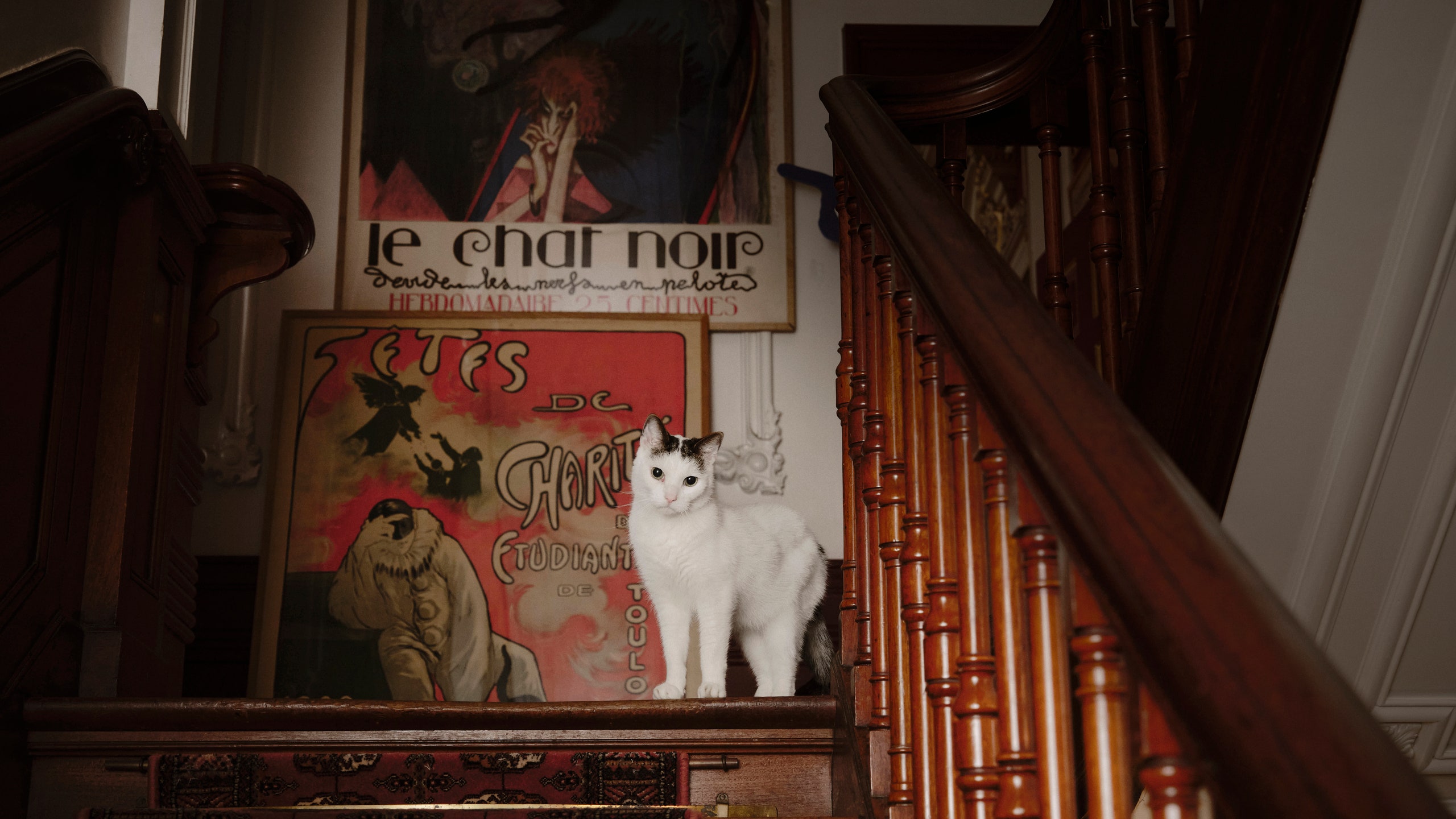In the late 1980s, Bob Meijer, a law student in Utrecht, veered from his studies to prioritise his responsibilities to a ginger-flecked tomcat over essay crises, lectures and libraries. This was no ordinary cat. Christened in honour of the American banker J.P. Morgan, he was (to borrow Kipling’s description) a ‘cat that walked by himself’. Their bond was more than just occasional strokes and tinned meals, however. Meijer and J.P. Morgan shared a deep friendship, with the pair celebrating the cat’s birthdays with legendary parties in his student digs. These festivities inspired the acquisition of a number of items of cat-themed memorabilia, forming part of what is dubbed – tongue firmly in cheek – a ‘cat-a-logue’ of works of art and illustrations depicting the animals that later graced the walls of his museum.
Today a sketched illustration signals the presence of the KattenKabinet on the Herengracht, one of the main canals in the maze of Amsterdam. Entering through the unassuming gift shop, visitors find themselves in a patrician merchant’s house dating from 1667. Towering over the canal, the monumental building’s attic space is now home to Meijer and his family, with the remainder serving as a public arena for all things cat-related. Behind concealed sliding doors, a small clowder of four-legged inhabitants greets visitors. These are the custodians of the space – Siri, Oscar, Billy, Villem and Nala – who roam the halls as if they owned them (which, in some ways, they do). Extroverted Billy leads the way, summoning guests into the jewel-box display of intriguing and decorative exhibits.
Paw-print stickers strategically placed on slabs of white marble form an itinerary for the trails through the three-room gallery. The dining room, ablaze with light, flaunts a ruby-red textile wall where original posters advertising 19th-century Parisian cabarets take centre stage. One, in particular, catches the eye. A drawing of May Belfort by Henri de Toulouse-Lautrec portrays the singer in 1895, holding her trademark black cat, with which she often performed on stage. Directly opposite are more comedic depictions. A copy of Abraham Teniers’s The Barbershop shows anthropomorphic hairdresser monkeys with their cat clients in a scene of gentle satire. Other objects are protected in glass cabinets from enthusiastic paws: these include a scroll of Chinese rice paper illustrated with sleeping cats, an image often associated with longevity. On the ceiling is a mural of dancing goddesses (the work’s importance confirmed by its state-protected status) mirrored by the playful kittens below.
In another corner, beside a ceramic pinball machine by Tadaaki Narita, sits a highly unusual piece of furniture. During a visit to the studio of the designers Charles and Ray Eames in 1950, the illustrator Saul Steinberg painted an impromptu image of a cat curled up on the seat of one of the Eameses’ famous shell chairs. There it remains, effectively turning the chair into a work of art in its own right.
One wall of the museum is given over to a more human hall of fame, being papered with paparazzi shots of icons of music, art and literature posing together with their majestic muses. It is an affectionate tribute by Meijer, who believes that ‘cats are like artists, wandering through the world on their own terms.’ Salvador Dalí is seen with his pet ocelot, Babou; Audrey Hepburn is shown accompanied by Orangey (one of the few cats to win a film award, for Breakfast at Tiffany’s) and Andy Warhol’s 25 cats, all named Sam, are stars in this display. Yet the ‘puss de resistance’, so to speak, is the room filled with paintings of such significance that even the likes of the Van Gogh Museum have sniffed around. Behind oak-panelled shutters, a glittering costume for Grizabella from the musical Cats reaches out toward an Egyptian mummified cat of c200 BC.
A skilled detective when it comes to cat-related works of art, Meijer has worked closely with antique dealers over the years to acquire some of the best finds. A triumphant acquisition was the terracotta sculpture Two Cats Making Love by Hildo Krop (1884–1970), a sketch by Pablo Picasso and a drawing by Rembrandt. In true collector fashion, Meijer also sources unique female artists, including Henriette Ronner-Knip (1821–1909), who made a career painting cats at a time when dog portraiture led the market. Yet it was Dutch painter Salomon ‘Sal’ Meijer’s paintings that were a major catalyst for the collection: the KattenKabinet’s holdings of his work are the most extensive in any museum. Elsewhere, tiny kittens delight in catnaps on mounds of lipstick-smudged letters written by globetrotting visitors.
Within the hallowed halls of the KattenKabinet, the spirit of its original feline muse, J.P. Morgan, still presides to welcome visitors.
Het KattenKabinet, Herengracht 497, Amsterdam. Visit kattenkabinet.nl
Sign up for our bi-weekly newsletter, and be the first to receive exclusive stories like this one, directly to your inbox.
